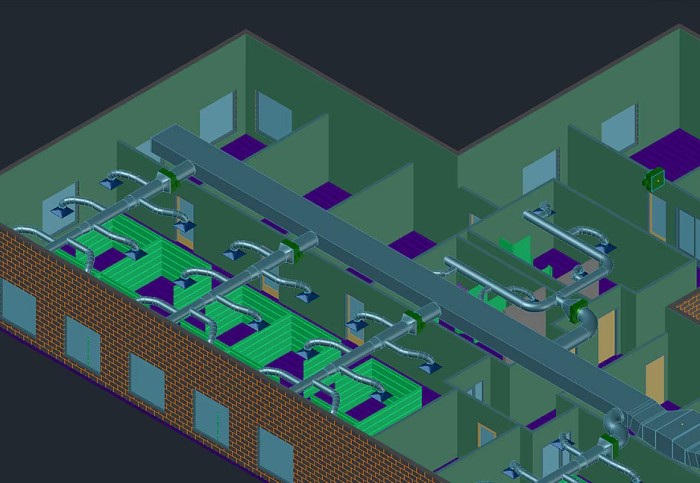Simplify MEP Design with AutoCAD's Precision
AutoCAD MEP Training in Dubai
Join our AutoCAD MEP (Mechanical, Electrical, and Plumbing) course to master drafting, designing, and documenting various building systems in AutoCAD. Learn to create and modify precise 2D and 3D geometry for MEP components. Our certification program in Dubai provides comprehensive training, expert instructors, and a curated curriculum to enhance your skills, advance your career, and excel in MEP engineering. Best AutoCAD MEP course in Dubai

What is AutoCAD MEP?
AutoCAD MEP is a simple AutoCAD with Mechanical, Electrical, and Plumbing (MEP) design sets Elements, and capabilities. Autodesk offers this same experience as AutoCAD with some other toolsets in AutoCAD MEP. AutoCAD MEP includes tools for HVAC, Plumbing, Piping, and Electrical as well as Schematics.
Why to choose this course?
Takes the same commands as AutoCAD, making it easy to use. It is a simplified interface for mechanical, electrical, and plumbing (MEP) professionals. Improved plan for documentation and design for walls, roofs, doors, and stairs.
AutoCAD is popular CAD software used by engineers because it is the most reliable and includes industry specific toolsets helpful for designing motor components, engines, and complete devices.
Who should attend this training?
AutoCAD MEP certification can be pursued by, anyone who has completed 10th or 12th standard. AutoCAD MEP training is usually attended by Mechanical, Electrical and Plumbing Engineers.

Course Outlet
ELECTRICAL DESIGN & DRAFTING COURSE
- Basics Concept of Electrical Engineering
- Ohm’s Law, Voltage, Current, Resistance, Power and Loads in series and parallel
- AC and DC currents
- How is AC Current generated, Transmitted, Distributed and Consumed
- DC and AC Generator, Transformers, Single and 3 phase Induction Motor
- Star Delta Connections
- Basics – Luminance
- Lux level recommended standard
- Types of lighting
- Mounting of lighting fixtures
- Illumination Calculations based on lux level in the particular area and selection of different types of lights
- Lighting load calculation
- Raw Power Load Calculation
- AC Load Calculation
- Peak Demand Calculation
- Parts of a transformers
- Cooling methods
- Types of transformers
- Losses in a transformer
- Transformer protection
- Transformer sizing
- Earthing of transformer
- Advantages of a DG set
- Types for DG sets
- Installation
- Protection
- Faults
- Sizing
- Introduction
- Working
- Battery sizes
- UPS sizing
- Battery sizing
- Types of Circuit Breakers
- Working Principle of Circuit Breaker
- Standard Sizes of Circuit Breakers
- Circuit Breaker Selection based on short circuit capacity
- Circuit breaker sizing
- Types of Cables
- Selection of cable
- Voltage drop calculations
- Short circuit calculations
- BUS BAR calculations
- BUS Duct
- Conduits & Cable trays
- Importance of Earthing,Points to Be Earthed
- Earthing calculations
- Calculation for Lightening arrestors
- Introduction to Capacitor Banks
- Advantages of improved power factor
- Capacitor Bank Sizing
- SLD
- Load Scheduling
- Lighting Layout
- Conduit Layout
- Wiring Layout
- Power Layout
- Designing of Villas & Apartments
- Designing of High Rise Building
- Designing of Malls
- AUTOCAD
- DIALUX
HVAC DESIGN COURSE
- Scope of HVAC Industry with overview of Consulting & Construction Industry
- Concepts of Air conditioning systems
- Principles of Air Conditioning systems
- Refrigerant cycle
- Window Air Conditioning
- Split Air Conditioning
- VRV – Air Conditioning
- VRV PROJECT DESIGN, ESTIMATION, BOQ
- Central Air Conditioning system
- Psychometric chart
- Properties of air
- Basics of Heat transfer in a building envelop
- Understanding of Outdoor & Indoor conditions
- Heat Gain Through Glass
- Heat Gain Through Wall
- Heat Gain Through Partition
- Heat Gain Through Roof/Ceiling
- Heat Gain Through Infiltration
- Heat Gain Through Ventilation
- Heat Gain Through People
- Heat Gain Through Kitchen Appliances / Electrical
- Components of Air distribution system
- Dampers
- Types of Diffusers
- Grills
- Duct size calculation manual & using software
- Heat Load Calculation Manual & E20 calculation excel software
- HAP Software (software shall be provided to students)
- U –Value selection
- Sample HAP calculations
- Types of Ducts, Ducts Fittings
- Duct designing – Equal friction method and Equal Velocity Method.
- Duct Aspect ratio and duct sizing
- Duct Materials selection and gauges selection
- McQuay duct sizer software
- Sample duct designing
- Chilled Water system pipe designing
- Chilled water and Hot water GPM calculation
- District cooling system
- Friction loss calculation for the piping system
- Friction loss in straight pipes
- Friction loss in Fittings
- Valves used in chilled water system
- Calculating TDH for pump (open piping system and closed piping system)
Learning Outcomes
AutoCAD MEP software helps you draft, design, and document building systems. Create more accurate designs within a familiar AutoCAD-based environment. Increase productivity and reduce errors with automated drafting tasks, manufacturers parts, and interference detection.
Benefits of learning AutoCAD MEP at Solve Tech Training Institute
- Our experienced professionals are instructing this course.
- Solve Tech provides you the facility to schedule the classes according to your availability.
- Following each session, you'll receive the course material for your own future reference.
- You will receive an internationally recognised certification after completing the course.
SOLVE TECH STUDENT BENEFITS

Focused Training

Placement Assistance

Lab Support

Expert Trainers

Flexible Timing

Interview Prepration

Hands on Training

